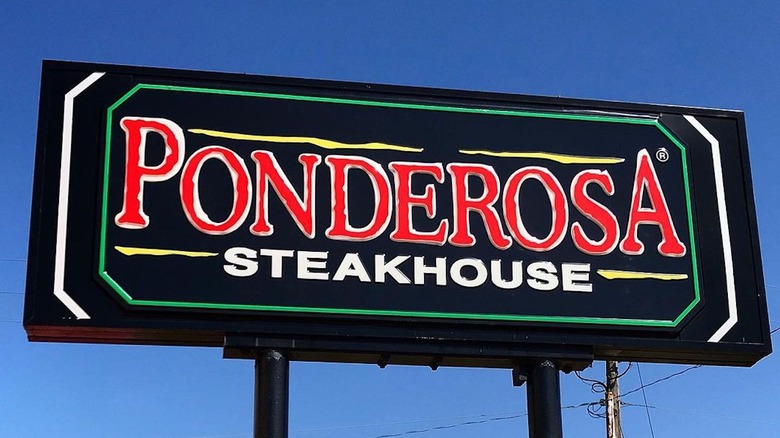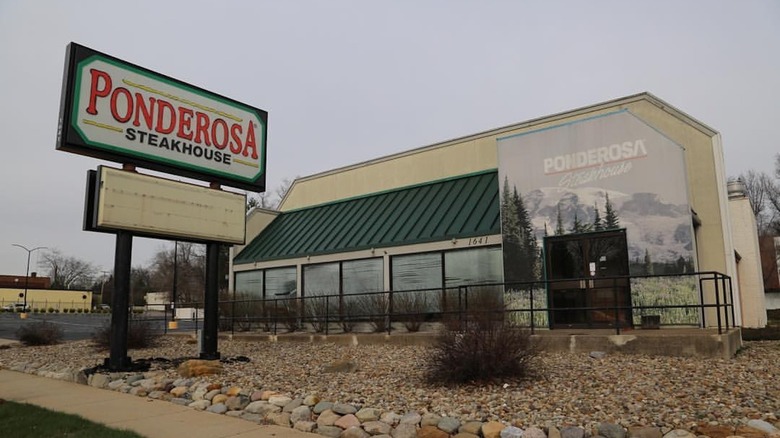Whatever Happened To Ponderosa Steakhouse Restaurant Chains?
Colonel Mustard in the kitchen with a knife? Nope, that's not who — or more accurately, what — killed Ponderosa Steakhouse restaurants. The demise of the once mighty Western-themed chain resulted from a confluence of events including a growing awareness of food safety issues. When the Centers for Disease Control began tracking incidents of food-borne illnesses in 1970, the link between all-you-can-buffets and the risk of contamination came into sharper focus. It wasn't the death knell, but consumers began to view serve-yourself set-ups with more suspicion than anticipation. It didn't happen immediately — and other factors also came into play — but over the course of a few decades, the appeal of the long-time family favorite began to erode. It's an interesting story of the rise and fall of an American restaurant chain.
In the 1960s, mid-century America was awash in cowboy drama. TV shows like "Bonanza," "Gunsmoke," "Rawhide," "The Rifleman," and "The Lone Ranger" ruled the airwaves. Perhaps driven by a romanticized version of the wild, wild west, suburban families of the 1950s and '60s routinely settled around their black-and-white televisions to tune into programming centered around the lives of fictional characters — righteous sheriffs, pretty barmaids, rugged ranchers, and wise family patriarchs — navigating life on the frontier. That fascination with the cowboy culture spilled over into real life with mid-20th-century toy stores showcasing everything from cowboy hats and spurs to cap guns and lassos. And in suburbs across the United States, Western-themed restaurants like Ponderosa Steakhouse were cashing in on the trend.
A trip down memory lane
With interior design that included dining rooms decorated with wagon wheels, staff decked out in cowboy hats and red-checkered shirts, and chuckwagon-style buffets, Ponderosa Steakhouse was a hit with families. Kids loved the kitsch, the seemingly endless buffet, and the all-you-can-eat sundae bar. Parents loved the fixed-price menu that made dining out affordable and predictable. The first Ponderosa Steakhouse opened in 1965 in Kokomo, Indiana — two years after actor Dan Blocker (Eric "Hoss" Cartwright on the television series "Bonanza") opened the first Bonanza Steakhouse in Westport, Connecticut. By the time Ponderosa rang the opening chow bell, Blocker had sold his stake in Bonanza to Texas brothers Sam and Charles Wyly.
In the glory days of buffet-style dining, Ponderosa operated more than 700 steakhouses worldwide. Bonanza peaked at almost 600 locations. After decades of going head to head, the one-time competitors united under one corporate umbrella in 1989 — but they each kept their name and branding. Times were changing. The Old West theme was still fun, but getting a bit stale. In 1994, Ponderosa debuted a branding upgrade that managed to retain the downhome ambiance while muting the cowboy connection. Both brands retained a loyal following well into the 21st century, but the one-two punch of the 2008 economic recession and the 2020 global pandemic took a toll. Today, the company website shows fewer than two dozen locations in the United States. Considering a trip down memory lane? The bulk of the remaining locations are in the mid-Atlantic and Midwestern states.

